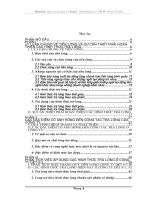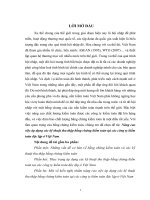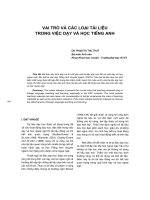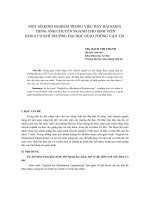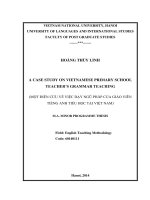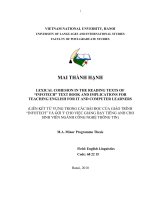Teaching ESL conversation through using lexical phrases = Việc áp dụng các cụm từ vựng trong việc dạy giao tiếp Tiếng Anh như ngôn ngữ thứ hai.PDF
Bạn đang xem bản rút gọn của tài liệu. Xem và tải ngay bản đầy đủ của tài liệu tại đây (1.17 MB, 60 trang )
v
TABLE OF CONTENTS
Certificate of originality i
Retention and use of the thesis ii
Acknowledgements iii
Abstract iv
Table of contents v
List of tables vii
List of figures viii
PART ONE: INTRODUCTION 1
1 Rationale of the study 1
2 Aim of the study 2
3 Research questions 2
4 Scope and limitations of the study 3
5 Significance of the study 3
6 Design of the study 3
PART TWO: THE STUDY 5
Chapter 1 Literature review 5
1.1 Lexical phrases 5
1.1.1 Review of lexical phrases 5
1.1.2 Definition of lexical phrases 5
1.1.3 Kinds of lexical phrases 6
1.2 What is communication? 7
1.2.1 Definitions and roles of communication 7
1.2.2 Characteristics of conversation 8
1.2.2.1 Conversation is lexis-centered not grammar-centered 8
1.2.2.2 Intonation phrases are very popular in spoken English 10
1.2.2.3 Language of conversation is vague 10
1.2.3 Spoken English: fluency or accuracy? 11
1.2.4 The “I- centric” in communication 12
vi
1.3 Lexical phrases and communication 12
1.3.1 Lexical phrases and communicative competence 12
1.3.2 Lexical phrases and conversation 15
1.3.3 Lexical phrases and oral fluency 17
1.4 Summary 19
Chapter 2 Methodology 20
2.1 Research questions 20
2.2 Subjects and data collection instruments 20
2.2.1 Subjects 20
2.2.2 Data collection instruments 22
2.2.2.1 Questionnaire for the students 23
2.2.2.2 Questionnaire for the teachers 24
2.3 Data collection procedures 24
2.4 Research method 25
2.5 Summary 25
Chapter 3 Data analysis and findings 26
3.1 Learners’ responses to the questionnaires 26
3.2 Teachers’ responses to the questionnaires 36
3.3 Major findings and discussions 42
3.4 Summary 42
PART THREE CONCLUSIONS 43
1 Conclusions 43
2 Implications 43
3 Suggestions for further study 43
BIBLIOGRAPHY 45
APPENDIX 1: STUDENTS’ QUESTIONANNAIRE (in Vietnamese) I
APPENDIX 2: STUDENTS’ QUESTIONANNAIRE (in English) IV
APPENDIX 3: TEACHERS’ QUESTIONANNAIRE (in Vietnamese) VII
APPENDIX 4: TEACHERS’ QUESTIONANNAIRE (in English) IX
vii
LIST OF TABLES
Table 3.1 Summary of students’ characteristics 21
Table 3.2 Teachers’ personal information 22
Table 4.1: Learners’ frequency of communicating with speakers of English 26
Table 4.2 Students’ self-assessment of speaking ability 27
Table 4.3: What do students usually learn to speak English well? 28
Table 4.4: Students’ opinion on grammatical rules and individual words 28
Table 4.5: Students’ frequency of learning words with functions 29
Table 4.6: Student’s frequency of pronunciation of words separately 29
Table 4.7 : Fluency and accuracy 30
Table 4.8 : Motivation in speaking English 31
Table 4.9: What makes students’ speaking less fluent? 31
Table 4.10: The frequency of using intonation phrases 32
Table 4.11: Students’ opinion on intonation phrases in spoken English 32
Table 4.12: Frequency of translating Vietnamese sentences into English ones 33
Table 4.13: Students’ frequency of creating sentences with grammatical rules and individual
words 33
Table 4. 14: Frequency of vague language usage 34
Table 4.15: What enhances English speaking? 35
Table 4.16: What teachers usually pay attention to when teaching speaking skill? 36
Table 4.17: Teachers’ opinions about fluency and accuracy in speaking English 37
Table 4.18: Teacher’s opinions on grammatical rules and individual words in creating
sentences 37
Table 4.19: Criteria to evaluate a good speaker 38
Table 4.20: Teachers’ opinion of pronunciation of every single word 39
Table 4. 21: Teachers and lexical phrases 39
Table 4. 22: Frequency of teaching intonation phrases …40
Table 4.23: Intonation phrases are popular in spoken English ….41
Table 4.24: Lexical phrases can enhance oral fluency and naturalness … 41
viii
LIST OF FIGURES
Figure 4.1: Frequency of speakers’ communicative opportunities with speakers of English
26
Figure 4.2: Students’ self-assessment of speaking ability 27
Figure 4.3: Students’ opinion on grammatical rules and individual words 28
Figure 4.4: Student’s frequency of pronunciation of words separately instead of in intonation
phrases 30
Figure 4.5: Fluency and accuracy 30
Figure 4.6: Frequency of translating Vietnamese sentences into English ones 33
Figure 4.7: Student’s frequency of creating sentences with grammatical rules and individual
words 34
Figure 4.8: Frequency of vague language usage 35
Figure 4.9: What enhances English speaking? 36
Figure 4.10: Teacher’s opinions on grammatical rules and individual words in creating
sentences 38
Figure 4.11: Criteria to evaluate a good speaker 39
Figure 4.12: Frequency of teaching intonation phrases 40
Figure 4. 13: Lexical phrases can enhance oral fluency and naturalness 41
1
PART ONE INTRODUCTION
This study examines the importance of lexical phrases in the teaching and learning of spoken
English. This chapter presents the rationale of the study. In addition, the aim, the research
questions, the significance and the design of the study will be presented along with its scope
and limitation.
1. The rationale of the study
It is useful to begin this part with the significance of English as an international language. It is
unarguable that English has an indispensable role to play in every field of life of every country
all over the world. As Crystal (1997) stated “English is now the language most widely taught
as a foreign language in over 100 countries, and in most of these countries, it is emerging as
the chief foreign language to be encountered in schools, often displacing other languages in
the process”.
Along with the widespread influence of English as an international language, the “open door”
policy of Vietnam also presents demands for better command of English to everyone,
especially, the college students who will be in the labor forces in the future. However,
according to Mrs. Tran Thi Ha, deputy director of University Education “there are only 49.3
percent of graduates who meet the employers‟ requirements of English, 18.9 percent of
graduates do not meet these requirements and 31.8 percent of them need to be
retrained.”(Translated by the writer) [Source: aad.vnuhcm.edu.vn. 15/09/2011]. Besides,
Widdowson (1979) stated that “students, especially students in developing countries, who
have received several years of formal English teaching frequently, remain deficient in the
ability to actually use the language and to understand its use in normal communication”
From this fact we can see that Vietnamese students are not very efficient in their English,
especially, speaking English.
From my own experience of teaching English over the years, I found that Vietnamese students
are extremely shy when speaking English and they usually speak English slowly and
unnaturally. I once encountered one student who surprised me a lot with the answer “No, I
wouldn’t like a cup of coffee” in response to my invitation “Would you like a cup of coffee?”
instead of “No, thanks” or “Yes, I love to” or when another student said hello to me saying “it
has been a long time since the last time I met you” instead of using “long time no see”. These
2
sentences are grammatically correct, yet they are obviously pragmatically inappropriate. This
bothered me for a long time about what I can do to help these students whose knowledge of
grammar is rather good but somehow fail to speak English efficiently and effectively. To my
surprise, I thought that these kinds of sentences should be taught at the very early stage of the
learning process such as how to reply to an invitation and greeting. This is may be as Hill
(2000) noticed that “the reason which so many students are not making any perceived progress
in communication is simply because they have not been trained to notice which words go with
which”. This leads students to contemplate carefully what they want to say and coin words at
their will. Consequently, their English is usually not natural and fluent.
This is the reason why I choose lexical phrases as the topic of my study with the hope of
finding something meaningful in helping students improve their speaking skill, particularly in
improving the fluency and naturalness in speaking English since the authors of Oxford
Collocations Dictionary (2002) state that “learning how words can be combined in English
will allow you to say what you mean- and say it more naturally”
2. Aims of the study
The study aimed at:
-Giving some theoretical information about the nature of spoken English.
- Finding out teachers and students‟ habits of learning spoken English as well as their opinions
on the roles of lexical phrases in spoken English.
-Providing some suggestions to the teaching and learning of spoken English.
3. Research questions
This study was guided by two following questions:
1. What are the habits of teaching and learning spoken English of teachers and students
at HUI?
2. What do teachers and students think about the roles of lexical phrases in spoken
English?
4. Scope and limitations of the study
The study was carried out with the help of the teachers and students of Ho Chi Minh
University of Industry (HUI). This study was based on quantitative method. Due to the
research methods of data collection, generalizations and recommendations will be limited to
3
the education setting at speaking classes of HUI only. The results of the study might not be
highly representative because the learners are just in three classes at HUI. The findings of the
study should be considered as tentative suggestions which would need further research. One of
the limitations of the study is that it is conducted just to collect the subjects‟ points of view of
the relationship between lexical phrases and spoken English. Therefore, there is a need of
practical experiments of how lexical phrases really work in spoken English.
5. Significance of the study
This study aims to provide an insight into the habits of teaching and learning speaking skill of
teachers and students. It also provides a new look on how teachers and students perceive the
roles of lexical phrases in spoken English. The significances of the study are presented as
follows:
1. This study presents some beliefs of students on how they usually learn speaking skill so
that we can navigate our teaching methodology in the future.
2. It provides some theoretical background information of spoken English that has been
ignored for a long time.
3. Through the answers of teachers and students, we will find out what is inadequate the
traditional way of teaching speaking skill from which we can adapt something practical
and necessary.
6. Design of the study
This study consists of 3 main parts:
Part One is the introduction providing background information to the study.
Part Two is the study. This part consists of 3 chapters:
-Chapter one: Literature review: this chapter provides the relevant literature in which the
theoretical background is mentioned to see the important roles of lexical phrases in teaching
and learning spoken English.
-Chapter Two: Methodology: describes the methodology of the study. This chapter includes a
presentation of the research questions, a discussion of the research design and a description of
the subjects, instruments, and data collection procedures.
-Chapter Three: Data analysis and findings: this chapter reports the results of the study and
discussions of the findings.
Part Three draws some conclusions and suggests some implications for further research.
4
PART TWO THE STUDY
CHAPTER 1: LITERARURE REVIEW
1.1. Lexical phrases
1.1.1 Review of lexical phrases
The term „lexical phrases’ was first coined by Becker (1975), then it came along with many
different labels, including “gambits” (Keller, 1979), “speech formulae” (Peters, 1983),
“lexicalized stems” (Pawley & Syder, 1983), “lexical phrases” (Nattinger & DeCarrico, 1992)
and “lexical bundles” (Biber &Barbieri, 2007; Cortes, 2002). However, it only came to
prominence in language learning and teaching and attracted marked attention from the work of
Nattinger & DeCarrico “Lexical phrases and language teaching” (1992). Since then, a lot of
researchers pay more and more attention to the increasing role of these prefabricated units in
language learning and teaching, especially in spoken English. It became a new trend in
language research when Michael Lewis (1993) coined the term “lexical approach” with some
following emphases:
1. Lexis is the basis of language.
2. Lexis is misunderstood in language teaching because of the assumption that grammar
is the basis of language and that mastery of the grammatical system is a prerequisite
for effective communication.
3. The key principle of a lexical approach is that “language consists of grammaticalized
lexis, not lexicalized grammar”.
4. One of the central organizing principles of any meaning-centered syllabus should be
lexis.
1.1.2 Definition of lexical phrases
First, lexical phrases belong to the bigger term called „formulaic sequences‟ which is defined
by Wray (2002) as “a sequence, continuous or discontinuous, of words or other elements,
which is, or appears to be, prefabricated; it is stored and retrieved whole from the memory at
the time of use, rather than being subjected to generalization or analysis by the language
grammar”. Formulaic sequences encompass collocations (e.g., bread and butter), phrasal verbs
(e.g., run into), idioms (e.g., a piece of cake), and figures of speech (e.g., as cold as ice); as
well as lexical phrases. However, lexical phrases are different from collocations since they are
5
“collocations, such as how do you do? and for example, that have been assigned pragmatic
functions” (Nattinger & DeCarrico, 1992). They are also different from phrasal verbs and
idioms for its somehow less fixed nature; therefore, in some cases, they give the users free rein
in coining new phrases which are pragmatically and grammatically acceptable.
1.1.3 Kinds of lexical phrases
According to Pawley and Syder (1983), finding the way to define certain categories of
language is difficult; therefore, we should “assert that this feature of gradation is a fact of the
language, and in seeking discrete classes we are in danger of misrepresenting the nature of the
native speaker‟s knowledge” (p.212). The Dictionary of Longman grammar of Spoken and
Written English divided lexical phrases into 14 major categories according to their structural
correlates. They include (1)personal pronoun+ lexical verb phrase (I don’t know what),
(2)pronoun/ noun phrase+ be (it’s going to be), (3)verb phrase with active verb (let’s have a
look at), (4)yes-no question fragments (can I have a), (5)wh-question fragments (what are you
going to do), (6)lexical phrases with wh- clause fragments (what I’m going to), (7)lexical
phrases with to-clause fragments (don’t want to go), (8)verb+ that clause fragments (thought it
was), (9)adverbial clause fragments (as soon as I ), (10)noun phrase expressions (something
like that), (11)propositional phrases expressions (for a long time), (12)quantifier expressions
(all of the sudden), (13)other expressions (on and on and on) and (14)meaningless sound
phrases (la la la, uhm). Although this type of classification is useful in terms of helping the
learners express the so-called “I- centric” in conversation which I will address later, these
categories are somehow confused to learners due to their lack of context.
On the contrary, Nattinger & DeCarrico (1992) divided lexical phrases into 4 categories based
on four structural criteria which I think much more suitable with the first criterion has to do
with their length and grammatical status; the second, with whether the phrases are canonical or
non-canonical; the third, whether the phrases are variable or fixed; and the fourth, whether the
phrases are continuous or discontinuous. They are of four categories:
1. Polywords: polywords are short phrases which function very much like
individual lexical items. They are continuous and allow no variability. They
can be either canonical like “in a nutshell, by the way, so to speak” or non-
canonical like “as it were, by and large, once and for all”.
6
2. Institutionalized expressions: they are lexical phrases of sentence level, usually
functioning as separate utterances. They are mostly continuous and invariable.
They are mostly canonical, for example, “a watched pot never boils, how do
you do”
3. Phrasal constraints: they are short-to-medium-length phrases. They are
continuous and allow variation of lexical and phrasal categories. They can be
both canonical (a day ago, a long time ago, ect ) and non-canonical (the…er
the…er, for better or for worse…)
4. Sentence builders: sentence builders are lexical phrases that provide the
frameworks for the whole sentence. They are both continuous and
discontinuous. They allow considerable variation of phrasal and clausal
elements: “not only X, but also Y (not only was her mother injured in the
accident, but also her father)” is a canonical sentence builder, while “the- er X,
the- er Y (the sooner all this work is finished, the sooner we will all be able to
go home)” is a non-canonical one.
The two former categories are somehow fixed; therefore, they do not allow much variation.
However, they prove to be useful in the first stage of the learning process where learners can
learn some sentences by heart since “there is nothing wrong with memorizing some essential
chunks, especially at the beginning stages of language learning” (DeCarrico, 1989). The two
latter categories are much more popular since they function as frames with slots for creating
phrases or sentences.
1.2 What is communication?
1.2.1 Definitions and roles of communication
We generally believe that the ability to communicate a language is the ultimate goal of
learning a language. This is not to say that making conversations is the only reason we learn a
language but rather it is the most prominent aspect of showing how good we are at mastering a
language through a certain period of learning it. Subject to different criteria, we have different
definitions of conversation. For example, Collin‟s COBUILD English dictionary defines
conversation as follows “if you have a conversation with someone, you talk with them, usually
in an informal situation”. This refers to the social context of conversation. In addition,
Longman dictionary of Contemporary English defines conversation as “the informal talk in
7
which people exchange news, feelings and thoughts”. This is all about the purposes of
conducting a conversation. To some extent, these two definitions are not very satisfying.
Personally, I find the following definition more suitable: “Conversation is the informal,
interactive talk between two or more people, which happens in real time, is spontaneous, has a
largely interpersonal function, and in which participants share symmetrical rights” (Scott
Thornbury and Diana Slade, 2006). From this definition I want to highlight the features „real
time, and spontaneous‟ of conversation to which lexical phrases can contribute the most.
It is believed that “the conversation session is sometimes regarded as a source of relief from
more serious language work. This should not prevent us from recognizing the important
functions it can perform in helping to develop communicative ability” (Littlewood, 1981).
From this point of view, we can identify two important features of conversation: the first one
is the ultimate role of conversation in developing communicative ability and the second is the
characteristics of conversation which I will address later in this study.
Nunan (1999) defines conversation as a way to verbally communicate for mostly interpersonal
and somewhat transactional purposes or the way to mark relationships (Richards and
Sukwiwat, 1983:117). However, I, personally, think that the major role of making
conversations is to show how competent we are in communicating what we want to say in a
language.
1.2.2 Characteristics of conversation
1.2.2.1 Conversation is lexis-centered not grammar-centered.
In this part, I have no intention to describe some generally thought features of conversation
such as the four conversational maxims of Grice (1975), „communicative need‟ (Doff, 1988),
adjacency pairs, topics and the like. In this part I will only present some characteristics of
conversation which the lexical phrases can be of great help in promoting the oral fluency and
the so-called native-likeness or naturalness.
First of all, we all notice that conversation is also “a type of speech event” (Hymes in Richards,
1980:14) and is different from other kinds of speech events such as lectures, discussions,
interviews and courtroom trials in which its prominence is the informality in style and
simplicity in structure with „short, frequent turns consisting of phrases and clauses‟ (Cook,
1989:51). And according to Nattinger & DeCarrico (1992), these phrases and clauses are
lexical phrases of different kinds.
